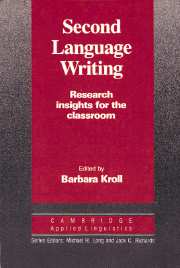Book contents
- Frontmatter
- Contents
- List of contributors
- Series editors' preface
- Preface
- Introduction
- I PHILOSOPHICAL UNDERPINNINGS OF SECOND LANGUAGE WRITING INSTRUCTION
- Chapter 1 Second language composition instruction: developments, issues, and directions in ESL
- Chapter 2 L1 composition theories: implications for developing theories of L2 composition
- Chapter 3 An overview of second language writing process research
- Chapter 4 Coaching from the margins: issues in written response
- Chapter 5 Second language writing: assessment issues
- Chapter 6 Reading–writing connections: toward a description for second language learners
- II CONSIDERATIONS FOR WRITING INSTRUCTION
- Index
Chapter 1 - Second language composition instruction: developments, issues, and directions in ESL
Published online by Cambridge University Press: 05 October 2012
- Frontmatter
- Contents
- List of contributors
- Series editors' preface
- Preface
- Introduction
- I PHILOSOPHICAL UNDERPINNINGS OF SECOND LANGUAGE WRITING INSTRUCTION
- Chapter 1 Second language composition instruction: developments, issues, and directions in ESL
- Chapter 2 L1 composition theories: implications for developing theories of L2 composition
- Chapter 3 An overview of second language writing process research
- Chapter 4 Coaching from the margins: issues in written response
- Chapter 5 Second language writing: assessment issues
- Chapter 6 Reading–writing connections: toward a description for second language learners
- II CONSIDERATIONS FOR WRITING INSTRUCTION
- Index
Summary
To be effective teachers of writing, English as a second language (ESL) composition professionals need an understanding of what is involved in second language (L2) writing. They need coherent perspectives, principles, models – tools for thinking about second language writing in general and ESL composition in particular, and for analyzing and evaluating competing views. This chapter attempts to supply some of these tools by focusing on approaches to ESL writing instruction – identifying what they are, what they are not, and what they might be. In particular, this chapter offers for consideration: (1) an interpretation of (and brief commentary on) developments in ESL composition instruction during the period 1945–1990; (2) some tentative models meant to provide a coherent context for understanding, describing, and evaluating approaches to the teaching of L2 writing; (3) an evaluation of existing approaches in terms of these models; and (4) suggestions, growing out of this evaluation, for future directions in ESL composition theory, research, and practice.
Historical sketch
There is no doubt that developments in ESL composition have been influenced by and, to a certain extent, are parallel to developments in the teaching of writing to native speakers of English. However, the unique context of ESL composition has necessitated somewhat distinct perspectives, models, and practices.
The history of ESL composition since about 1945 – the beginning of the modern era of second language teaching in the United States – can be viewed as a succession of approaches or orientations to L2 writing, a cycle in which particular approaches achieve dominance and then fade, but never really disappear.
- Type
- Chapter
- Information
- Second Language Writing (Cambridge Applied Linguistics)Research Insights for the Classroom, pp. 11 - 23Publisher: Cambridge University PressPrint publication year: 1990
- 77
- Cited by

